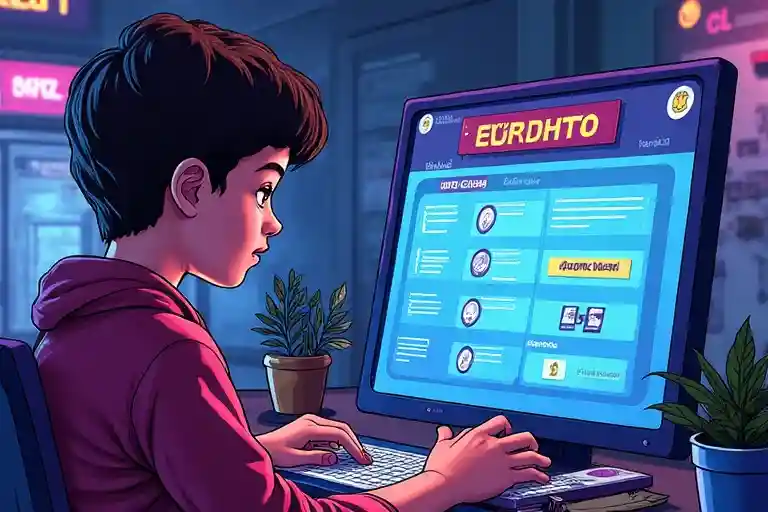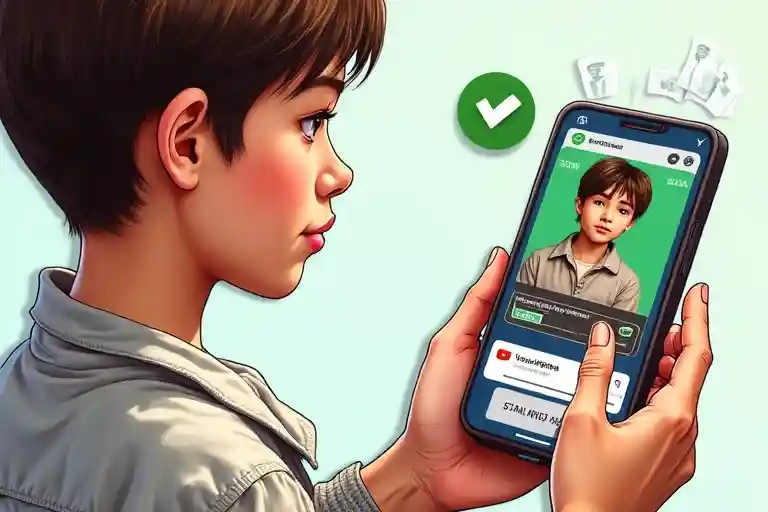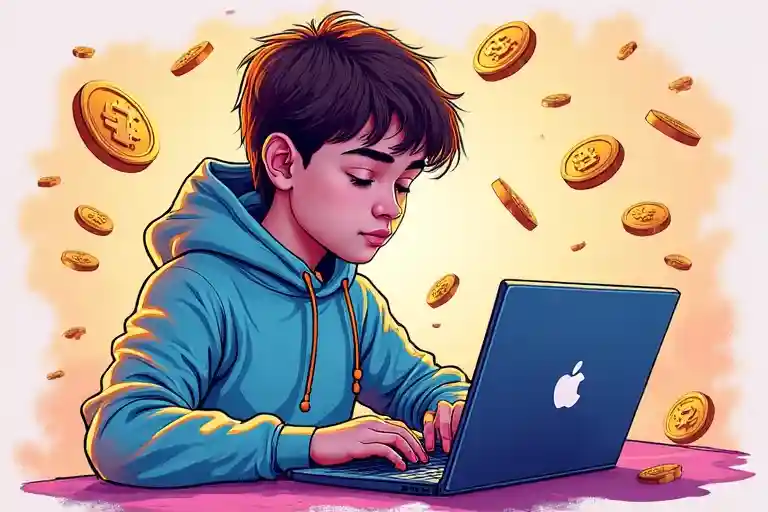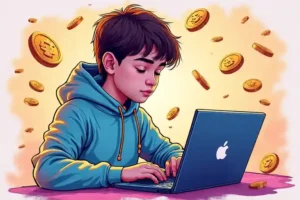Alright, let’s talk crypto! You’ve probably heard about Bitcoin, Dogecoin (much wow!), or seen those TikToks with people striking it rich. The big question is, can YOU actually earn money from cryptocurrency as a teen? The short answer? Yes, it’s possible! But hold up – it’s not usually like those “get rich quick” videos. Think of it more like an exciting new world to explore, with some cool chances to earn a bit, learn a LOT, and maybe even build some future skills. This guide is your a_d_v_e_n_t_u_r_e_ map to navigate how to earn money from cryptocurrency, focusing on ways that are generally more suited for teenagers, especially in the U.S. We’re talking real methods, practical advice, and SUPER important safety tips because, let’s be real, nobody wants to get scammed. We’ll dive into everything from getting tiny bits of crypto for free to learning about the tech that powers it all. And hey, maybe you’ll find your next big passion or a cool way to save up for something awesome. Ready to see what’s out there? Let’s go!
Before we jump into the “how,” it’s essential to understand that the crypto world can be a bit like a rollercoaster – exciting, sure, but also with ups and downs. That’s why going in with a learning mindset is key. Many platforms and methods to earn money from cryptocurrency might require parental permission or have age restrictions (usually 18+ for direct investing or trading on major exchanges), so always, ALWAYS check the terms and, more importantly, chat with your parents or a trusted adult before you dive in. This isn’t just about following rules; it’s about keeping you and your potential earnings safe. Think of them as your co-pilots on this crypto journey! For some initial ideas on beginner-friendly platforms, you might want to explore crypto earning platforms for beginners.
Understanding the Basics: What is Cryptocurrency Anyway?
Okay, so before we even think about how to earn money from cryptocurrency, what *is* it? Imagine digital money that isn’t issued by a bank or government. It’s secured by something super techy called cryptography (hence “crypto”), which makes it really hard to counterfeit. Cryptocurrencies run on a technology called blockchain, which is like a giant, shared digital ledger that records all transactions. Think of it like a Google Doc that everyone in a group can see and update, but no single person can secretly change without others noticing. Bitcoin was the first one, the OG, but now there are thousands, like Ethereum, Solana, and even some fun ones like Dogecoin (which started as a meme – seriously!).
Why should you care? Well, except the potential to earn, knowledge crypto is like getting a sneak peek into the destiny of finance and era. It’s all approximately decentralization, meaning no unmarried point of manage. This may be a large deal! For teenagers, greedy these concepts early can be a huge advantage, whether or not making a decision to pursue crypto incomes or not. It’s like gaining knowledge of coding in the early days of the internet – quite cool, proper? The price of maximum cryptocurrencies can cross up and down… A LOT. This is called volatility. It’s why you must by no means installed cash you can’t find the money for to lose, specially whilst you’re simply starting out. Focus on gaining knowledge of and exploring low-threat techniques first. This adventure is a marathon, not a dash (or a TikTok dance challenge, although the ones are amusing too!).
So, It’s Real Money?
One of the first questions people ask is: “Does cryptocurrency pay real money?” Yes, it absolutely can. Cryptocurrencies can be traded for traditional currencies like US dollars, Euros, etc., on exchanges. People use crypto to buy goods and services, invest, and more. However, turning your crypto into cash in your bank account involves a few steps, usually through an exchange, and there might be fees. So, while it’s not physical cash you can hold (unless you’re using a crypto pay card), it has real-world value.
How to Make Money with Bitcoin for Free
You read that right – “free”! While you won’t get rich overnight picking up free Bitcoin, there are legit ways to accumulate small amounts without spending your own cash. This is a fantastic way for teens to dip their toes into the crypto world and earn money from cryptocurrency, however small, with minimal risk. Think of it like finding loose change, but digital and with the potential to grow (or shrink, remember volatility!).
These methods usually contain finishing small responsibilities, getting to know, or just being in the right region on the proper time. It’s much less about creating a fortune and more approximately getting familiar with how crypto transactions work and proudly owning a tiny piece of the digital pie. Remember that “free” regularly approach you are “paying” together with your time or statistics. Always research platforms thoroughly and, say it with me, talk for your mother and father!
Crypto Faucets: Tiny Drops Adding Up
Crypto faucets are websites or apps that give out tiny amounts of cryptocurrency for free, usually in exchange for completing simple tasks. These tasks could be anything from watching ads, solving captchas, or taking short surveys. The amounts are small – like, really small, think fractions of a cent – but hey, it’s a start! It’s like those mobile games where you tap a lot for small rewards. The idea is that these tiny drops can add up over time, especially if the value of the crypto increases. Popular faucets often support Bitcoin or other well-known cryptos.
To get started, you’ll usually need a crypto wallet address for the specific coin the faucet dispenses. Many teens start here because the barrier to entry is super low. It’s a patient game, like waiting for your favorite influencer to drop new merch. For more on this, checking out a guide on how to earn free crypto with faucets can be super helpful. Reputable sources like CoinbaseBest Crypto Faucets 2025 often list platforms, but always do your own research too, as platforms change.
Learn-to-Earn Programs: Get Paid to Get Smarter!
Okay, this is a REALLY cool way to earn money from cryptocurrency and boost your brainpower at the same time. Several crypto platforms and projects offer “learn-to-earn” programs. Basically, you watch educational videos or read articles about specific cryptocurrencies or blockchain technology, then take a short quiz. If you pass, you get rewarded with a small amount of that crypto. Coinbase Earn is a well-known example, though access can vary by region and age. It’s like getting paid for doing your homework, but way more interesting (probably!).
These programs are awesome because you’re not just getting free crypto; you’re gaining valuable knowledge about the projects and the wider ecosystem. This understanding is way more valuable in the long run than the few dollars you might earn. Imagine explaining blockchain to your friends and actually knowing what you’re talking about – major flex!

How to Make Money in Crypto Without Money
This sounds like the dream, right? And it builds on the “free” methods we just talked about. Beyond faucets and learn-to-earn, there are a few other avenues where you don’t need to invest your own cash upfront to potentially earn money from cryptocurrency. These often require more effort, skill, or sometimes just good timing and a bit of luck. But the key is, your bank account stays untouched for the initial plunge.
Think about skills you might already have or be developing. Are you creative? Good at gaming? Enjoy being part of online communities? These can all be pathways. The crypto world is surprisingly diverse in its opportunities. It’s not just for the tech wizards or financial gurus. Your unique talents might just be your ticket in. Remember, “no money down” doesn’t mean “no effort,” though!
Airdrops: Free Tokens Dropping In
Airdrops are like surprise gifts from new crypto projects. To promote a new token or blockchain, projects will often distribute a certain amount of their new crypto for free to existing crypto holders (often of a specific coin like Ethereum or Solana) or to people who complete simple promotional tasks. These tasks might include following them on social media, joining their Telegram group, or retweeting a post. It’s like a new brand giving out free samples at the mall to get people interested. (Totally dating myself with the mall reference, huh? Think… a popular creator dropping free digital merch to their followers!).
Finding legitimate airdrops can be tricky, as there are many scams. It’s crucial to use reputable sources for airdrop listings, like Airdrops.io or CoinGecko’s airdrop section. Never share your private keys (super-secret passwords for your crypto wallet) or send crypto to receive an airdrop – real airdrops don’t ask for that. Being part of an airdrop can be exciting, and if the project takes off, those free tokens could become valuable. For teens specifically looking into this, the guide on airdrops for teens offers more tailored advice.
Play-to-Earn (P2E) Games: Gaming Your Way to Crypto
If you’re a gamer, this one’s for you! Play-to-Earn (P2E) games are blockchain-based games where you can earn cryptocurrencies or Non-Fungible Tokens (NFTs) – unique digital collectibles – by playing. Think of it like earning in-game currency, but this currency can often be traded for real money or other cryptos. Games like Axie Infinity (though it’s had its ups and downs and often requires an initial investment in NFTs) popularized this model, but many new P2E games are emerging, some with lower barriers to entry.
The earnings can vary wildly, and some games require a significant time investment to see returns. Also, the value of in-game assets can be just as volatile as other cryptos. For teens, it’s important to choose games that are age-appropriate and don’t require huge upfront costs. Always research the game, its community, and its earning potential. And, you guessed it, parental guidance is a good idea, especially if any investment *is* needed. It’s like, “Mom, Dad, can I get this game? It *could* pay for itself!” (Results may vary, LOL).
Content Creation & Community Engagement (Bounties/Micro-tasks)
Many crypto projects and platforms rely on their communities. If you’re good at writing, making videos (hello TikTok!), graphic design, or even just being an active, helpful member of an online community (like on Discord or Telegram), you might find opportunities. Some projects offer “bounties” for creating promotional content, translating documents, finding bugs, or moderating forums. These are essentially small freelance gigs paid in crypto.
This is a fantastic way to earn money from cryptocurrency by using skills you might already be building. It also helps you network within the crypto space. Platforms like Reddit (r/Jobs4Bitcoins, but be cautious and vet thoroughly) or specific project forums sometimes list these. It’s less direct than an airdrop but can be more consistent if you find the right niche. Think of it as leveling up your existing talents with a crypto reward at the end of the quest!
How to Make Money with Bitcoin for Beginners
Once you’ve explored the “free” and “no money down” options, you might be curious about other ways to engage with Bitcoin and other cryptocurrencies. For beginners, especially teens, the emphasis should always be on *learning* and *caution*. The crypto market is known for its “wen Lambo?” memes, but the reality is that significant earnings often come with significant risk or significant knowledge and experience.
Before considering putting any of your own money (or allowance!) into crypto, make sure you’ve done your homework. Understand the basics of what Bitcoin is, how wallets work, and the importance of security. Start small – *really* small – and only with money you can truly afford to lose. This isn’t about getting rich; it’s about experiential learning. Consider exploring resources on developing a crypto profit strategy, even if you’re starting with tiny amounts, to build good habits.
Staking and Yield Farming (More Advanced, Use Caution)
Okay, we’re getting into slightly more complex territory here, and these methods often involve locking up your existing crypto to earn more. *This means you need to have some crypto first*.
Staking is a bit like earning interest in a savings account. Some cryptocurrencies use a system called “Proof of Stake” to verify transactions. By “staking” your coins, you help secure the network and get rewarded with more coins.
Yield Farming is more complex and riskier. It involves lending or pooling your crypto assets in decentralized finance (DeFi) protocols to earn rewards, often in the form of more crypto. It can offer higher returns but comes with higher risks like “impermanent loss” (which is as fun as it sounds) and smart contract vulnerabilities (bugs in the code).
For teens, if you’re exploring this, it should be with *very* small amounts, on reputable platforms, and with full parental understanding and consent. These are not “set it and forget it” for beginners. The crypto world has its own lingo, and things like “APY” (Annual Percentage Yield) can look tempting, but understanding the risks is paramount. It’s like going from the kiddie pool (faucets) to the wave pool – more exciting, but you need to be a stronger swimmer. Some platforms try to make crypto passive income accessible, but “passive” rarely means “risk-free.”

How to Trade Cryptocurrency and Make Profit
This is often what people think of when they hear “earn money from cryptocurrency.” Trading involves buying cryptocurrencies at one price and selling them at a higher price. Sounds simple, right? Well, not exactly. It requires knowledge, skill, emotional control, and a good understanding of market analysis. It’s also very risky, especially for beginners and teens, as prices can change incredibly fast. Imagine trying to predict the next viral TikTok sound – sometimes you nail it, sometimes you… don’t.
Most professional traders use sophisticated tools, charts, and strategies. For a teen, jumping into active trading with real money without significant education and practice (like paper trading – using fake money on real market data) is generally not advisable. The allure of quick profits is strong, but the reality of quick losses is just as real. This section is more about understanding what trading *is* rather than a direct recommendation for most teens to start doing it with significant amounts.
Learning About Trading: Paper Trading & Education
If you’re interested in the *idea* of trading, the best first step is education. Learn about technical analysis (reading charts), fundamental analysis (researching projects), market sentiment, and risk management. Many exchanges offer “paper trading” accounts where you can practice trading with virtual funds. This is like using a flight simulator before actually flying a plane – super important!
There are tons of free educational resources online, from YouTube channels to articles and courses. Focus on credible sources. Remember, anyone promising guaranteed profits in trading is likely a scammer. Real trading is hard work. The goal here, especially as a teen, isn’t to become a millionaire trader overnight but to understand the mechanics and risks. If you do explore this, even with paper trading, discussing your crypto profit taking strategy with a mentor or parent can be a good learning experience.
Can You Make $100 a Day Trading Cryptocurrency?
You’ll see headlines and YouTube thumbnails screaming this: “I Made $100 (or $1000!) a Day Trading Crypto!” Is it possible? Yes, for some experienced traders with significant capital and a high-risk tolerance, it *can* happen. Is it realistic or advisable for a teenager just starting out? Honestly, no, not really, and aiming for this can lead to risky behavior.
To make $100 a day consistently through trading typically requires a substantial investment, a deep understanding of the markets, and often, a lot of stress. The crypto markets are 24/7, which can be all-consuming. For every story of someone making big daily gains, there are many more (often untold) stories of people losing significant amounts. Instead of focusing on a specific daily monetary target, especially a high one, a better goal for a teen is to learn, experiment safely with small amounts (if at all in active trading), and understand the risks. Trying to calculate potential daily earnings with a crypto profit calculator might be interesting, but always remember it’s speculative.
Staying Safe: Avoiding Scams in the Crypto World
This is THE most important section. Seriously. The crypto space is exciting, but because it’s new and sometimes confusing, it attracts a lot of scammers. They’re like those fake celebrity accounts sliding into your DMs – too good to be true! Knowing how to spot and avoid scams is crucial to safely earn money from cryptocurrency (and not *lose* it!).
Common Scam Tactics:
- “Too Good to Be True” Promises: Guaranteed high returns, “double your crypto” schemes – if it sounds too easy, it’s almost certainly a scam. No one can guarantee profits in crypto.
- Impersonation: Scammers might pretend to be famous people (like Elon Musk), support staff from exchanges, or even your friends. They’ll create fake social media profiles or send phishing emails. Always verify identities through official channels.
- Phishing Attacks: Fake login pages for wallets or exchanges designed to steal your passwords and private keys. Always double-check website URLs and use bookmarks for official sites. Never click suspicious links from emails or DMs.
- Pump and Dump Schemes: Groups coordinate to buy a small, unknown coin to inflate its price (“pump”), then they all sell simultaneously (“dump”), causing the price to crash and leaving latecomers with worthless tokens. Be wary of sudden hype around obscure coins.
- Fake Airdrops/Giveaways: Scams that ask you to send crypto to an address to receive more back, or ask for your private keys/seed phrase to “verify” you for an airdrop. Real airdrops DON’T do this. Your private keys are for YOUR EYES ONLY.
Safety First Checklist:
- Parental Guidance: Yes, I’m saying it again! Discuss your crypto activities with your parents or a trusted adult. Their experience can be invaluable.
- Strong, Unique Passwords & 2FA: Use strong, unique passwords for every crypto platform and enable Two-Factor Authentication (2FA) wherever possible. It’s like having an extra lock on your digital vault.
- Secure Your Seed Phrase: If you use a non-custodial wallet (where you control your keys), write down your seed phrase (recovery phrase) and store it offline in a safe, secret place. Never share it with anyone or store it digitally where it could be hacked.
- DYOR (Do Your Own Research): Before investing in any coin, using any platform, or participating in any scheme, research it thoroughly. Check reviews, project teams, whitepapers, and community sentiment. Don’t just trust influencers.
- Start Small & Be Skeptical: Especially as a teen, only use small amounts of money you can afford to lose. Be highly skeptical of unsolicited offers or DMs. If your gut says something is off, it probably is. “Trust me, bro” is not a valid investment strategy.
If you ever need help with a platform, make sure you’re using official channels, for example, looking for CryptoPay support if you’re using their services.
Why Cryptocurrency is Bad (Or Rather, Risky and Misunderstood)
You might hear some people say “cryptocurrency is bad.” While it’s not inherently “bad,” there are definite risks and downsides, especially for newcomers and younger individuals. Understanding these helps you make informed decisions if you choose to earn money from cryptocurrency.
Volatility: This is a big one. Prices can swing wildly. You could see your crypto value go up, but it could also drop dramatically very quickly. This makes it a risky place for money you can’t afford to lose (like your savings for college or a new phone!).
Scams & Security Risks: As we just covered, the space is RIFE with scams. Because it’s decentralized and transactions are often irreversible, if you get scammed, getting your money back is incredibly difficult, if not impossible.
Complexity: Let’s be honest, crypto can be confusing! Understanding the technology, the different coins, wallets, and exchanges takes time and effort. It’s not as simple as using Venmo (though some platforms are trying to make it easier).
Environmental Concerns: Some cryptocurrencies, like Bitcoin (which uses “Proof of Work”), require a LOT of energy to mine and maintain their networks. This has led to valid environmental concerns, though newer cryptos are often more energy-efficient (using “Proof of Stake”).
Regulatory Uncertainty: Governments around the world are still figuring out how to regulate crypto. This means rules can change, impacting how you can buy, sell, or use cryptocurrencies. Taxes on crypto earnings are also a thing, and they can be complicated!
It’s not about being scared off, but being *aware*. This is cutting-edge stuff, and the cutting edge can be a bit chaotic. Knowing the potential downsides helps you navigate more safely and decide if it’s even for you. The goal is to explore, learn, and maybe earn a little, not to gamble away your savings or get into hot water.
Comparing Methods to Earn Money From Cryptocurrency
To give you a clearer picture, let’s compare some of the methods we’ve discussed. Remember, “potential earnings” are highly speculative and can vary wildly! This is just a general guide for teens.
| Method | Effort Level | Potential Earnings (Initial) | Risk Level | Parental Guidance Recommended? | Typical Age Consideration |
|---|---|---|---|---|---|
| Crypto Faucets | Low (repetitive tasks) | Very Low (fractions of cents) | Low (mostly time, some scam site risks) | Yes (for platform safety) | 13+ (platform dependent) |
| Learn-to-Earn | Low-Medium (learning & quizzes) | Low (few dollars per course) | Very Low | Yes (for platform signup) | Varies (often 18+, or parental account) |
| Airdrops | Low-Medium (social tasks, holding crypto) | Variable (from $0 to potentially higher if project succeeds) | Medium (scam airdrop risks, token value volatility) | Yes (vetting projects) | Varies (often need existing wallet/crypto) |
| Play-to-Earn Games | Medium-High (gameplay time & skill) | Variable (can be low, some high if skilled/lucky & game is popular) | Medium (game asset volatility, initial investment if any) | Yes (game suitability, any costs) | Varies by game (check ESRB/PEGI equivalent) |
| Content/Community Bounties | Medium (skill-dependent tasks) | Low-Medium (per task) | Low-Medium (scam projects, payment issues) | Yes (vetting projects) | 13+/16+ (depends on skill & platform) |
| Staking (Beginner Level) | Low (after setup) | Low-Medium (percentage-based on amount staked) | Medium (requires owning crypto, platform risk, lock-up periods) | Strongly Yes | Likely 18+ for direct access, or via parent |
| Active Trading | Very High (learning, time, stress) | Very Variable (high potential loss) | Very High | Strongly Yes (and generally not recommended for teens with real money) | 18+ for most exchanges |
This table should help you see that there’s no single “best” way to earn money from cryptocurrency; it depends on your interests, skills, risk tolerance, and (crucially!) what your parents are comfortable with. The lower-risk, lower-effort options like faucets and learn-to-earn are great starting points for any teen.
Conclusion
So, there you have it! Exploring how to earn money from cryptocurrency can be a super interesting journey for teens. It’s about more than just the money; it’s about learning new tech, understanding digital ownership, and maybe even finding a new hobby or skill. From tiny drips from faucets to the potential of play-to-earn games or even (cautiously!) learning about staking, there are paths for different interests. The most important things? Stay curious, prioritize learning, and *always* put safety first. Talk to your parents, do your own research (DYOR!), and never invest more time or money than you’re comfortable losing. The crypto world is still young and evolving, kind of like you! What starts as a small interest today could be a big part of your future.
What are your thoughts? Are you going to try any of these methods? Share this article with your friends if you found it helpful, and maybe even film a TikTok about your crypto learning journey (tag us if you do!). We’d love to hear your experiences!
Stay Updated! The crypto world changes FAST. New platforms pop up, regulations evolve, and new ways to earn money from cryptocurrency emerge. Keep checking back on sites like Zana.website for the latest info and guides tailored for you. Last updated: June 2025.
Frequently Asked Questions
1. Can you actually make money off crypto?
Yes, you can actually make money off crypto through various methods like trading, staking, faucets, airdrops, or play-to-earn games. However, it’s important to remember that all methods come with risks, and earnings are never guaranteed. Volatility is high, so be cautious.
2. Can you make $100 a day with crypto?
While some experienced traders with significant capital might make $100 a day with crypto, it’s not realistic or advisable for beginners, especially teens. It requires substantial investment, skill, and carries high risk. Focus on learning and safer, lower-yield methods first.
3. How do I earn money on crypto?
You can earn money on crypto by participating in crypto faucets for small rewards, joining learn-to-earn programs, looking for airdrops, playing play-to-earn games, or (with more risk and knowledge) through staking or trading. Always research and understand the risks involved with each method.
4. Does cryptocurrency pay real money?
Yes, cryptocurrency can be converted into real money, like US dollars or other traditional currencies, through cryptocurrency exchanges. You can then withdraw this money to your bank account. So, while digital, it can translate to tangible financial value, though fees may apply.









